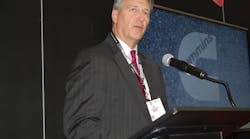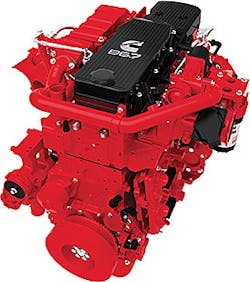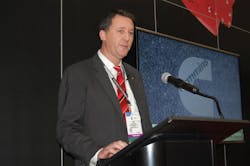INDIANAPOLIS. When it comes to midrange diesel engines, the focus at Cummins Inc. is how to keep bringing the “best of both worlds” together, according to Jeff Caldwell, the company’s executive director of North American truck OEMs – more fuel economy and more performance, all within the same package.
A different set of demands, however, is present within the natural gas segment of the midrange engine market, noted Rob Neitzke, president of Cummins Westport Inc. (CWI), during a press conference here during the 2017 National Truck Equipment Association (NTEA) Work Truck Show: how to deliver a super-low oxides of nitrogen (NOx) emitting truck engine that doesn’t sacrifice on power while helping “non-attainment” areas meet Clean Air Act (CAA) air pollution targets.
“There’s a scattershot of place across the U.S., largely in major metropolitan areas, that are having trouble meeting the 8-hour ozone targets established by the CAA for 2023 and 2030,” Neitzke explained to Fleet Owner.
“Looking at their glide path, we can provide an engine that offers 90% NOx [emission] improvement that changes their compliance direction while still providing diesel-comparable power,” he said. “One of the myths of the natural gas engine is that it’s a ‘bridge’ technology to something else. Instead we’re saying it’s a solution to a problem right now.”On the pure diesel engine side, Cummins’ Caldwell noted that the company’s 2017 model B6.7 base engine is seeing an average improvement of 8.5% on efficiency ratings and 5% improvement in performance ratings over its 2013 model ISB6.7 engine. For some applications and duty cycles, specifically pickup and delivery, the efficiency ratings are up to a 13% gain in fuel economy versus the 2013 ISB6.7.
"Our program started with a goal of delivering 7% better fuel economy on the efficiency ratings and 1% better fuel economy on the performance ratings over the 2013 product,” Caldwell noted. “As the program progressed, we found opportunities to tune and optimize the engine, delivering further efficiency, and allowing us to surpass initial expectations."
Apart from base engine fuel economy enhancements, Cummins also has Stop-Start capability with the B6.7, which will provide additional fuel economy improvement of 3% to 15% by automatically shutting off the engine during idle time, resulting in reduced fuel consumption.
The 2017 model B6.7 also comes with a newly-extended 3-year/unlimited-mile warranty in truck applications, Caldwell said.
“The trick is how do I continue to gain fuel economy without losing performance,” he told Fleet Owner. “That’s why diesel still has a role in this industry; it is still the most effective way to make trucks more productive.”
On the natural gas side of the ledger, Cummins Westport noted that its ISB6.7 G and the ISL G Near Zero engines are now in full production for bus, medium-duty truck and vocational applications.
Yet CWI’s Neitzke said the ISL G Near Zero engine is the real “game changer” in the market – a ge engine that’s received emissions certification from both the Environmental Protection Agency (EPA) and the California and Air Resources Board (CARB) to meet the optional 0.02 g/bhp-hr Near Zero NOx emissions standards – some 90% lower than the 2010 EPA standard of 0.2 g/bhp-hr.
"This engine offers customers the benefit of performance with the lowest emissions at a much lower cost than battery electric-vehicles,” Neitzke stressed. “It is zero-emissions technology at conventional propulsion system costs."
Both the ISB6.7 G and ISL G Near Zero operate exclusively on compressed natural gas (CNG), liquefied natural gas (LNG) or renewable natural gas (RNG), and both use CWI’s proprietary spark-ignited stoichiometric combustion with cooled exhaust gas recirculation (SEGR) technology. In addition, the engines feature electronic controls with programmable features, a closed crankcase ventilation system and a maintenance-free Three-Way Catalyst (TWC) aftertreatment.
“You’re getting electric-like emissions with traditional diesel-like response,” Neitske added to Fleet Owner regarding the ISL G Near Zero engine. “You can use the same technicians and almost the same maintenance processes and drop [the engine] into the same chassis space as a traditional diesel. It’s a fantastic low-emission solution and it’s in production today.”





